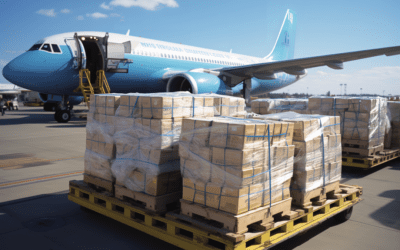As we now fully leave 2022 in the rearview, we can admit that it brought more change to the global supply chain than ever before. To be optimistic, it made countries rethink the way that they do business with each other, and pushed industry professionals to seek better and more sustainable practices. In our 2023 Outlook, we see what is to come and what we can learn from the recent past.
Looking at the empty part of the glass, supply chain disruptions were a leading cause of inflation, and the war in Ukraine created a crisis for energy supply in Europe and rearranged the layout of global trade that had been in place for decades.
Back to the brighter side, auto manufacturers started making big plans to implement electric vehicles into their lineups, and shippers and manufacturers are investing more in automation amid labor shortages and rising costs. What changes can we expect to see in 2023 as a result of 2022?
Article Overview
Global Shift in Trade and Manufacturing
China, the world’s second-largest economy, was pushing its population to its limits while pursuing its “zero-COVID” initiative. The economic impact was severe and one that the country is still working to recover from.
Not only did this affect consumer spending in the country, but it temporarily shut down major ports that are an essential part of not only China’s economy but other countries as well. This caused major supply chain issues and motivated countries to re-examine their trade partners and who they could rely on.
It wasn’t long after that The Biden Administration developed its Indo-Pacific Economic Framework for Prosperity (IPEF) in an effort to lean countries off of their dependency on China. The IPEF consists of 14 nations that make up 40% of global trade.
Additionally, companies are moving their manufacturing operations away from Asia. Industrial hubs are popping up in Mexico as they seek to nearshore and be closer to their primary market — the United States. Direct foreign investment in Mexico reached $32.1 billion by September 2022. Even as this piece is being written, Tesla announced that it plans to build a manufacturing plant in Monterrey.
We will see an enormous shift in trade and manufacturing in 2023 that will break old bonds and form new ones.
Inflation
The COVID-19 pandemic left global supply chains in shambles, but consumer demand reached an all-time high. This was due to the distribution of stimulus checks and the restrictions on attending sporting events or taking vacations, leading to an overheated economy
By June 2022, the inflation rate peaked at 9.1% — its highest since the early 1980s. The increase caused panic among consumers, and retailers felt the effects during the holiday season.
Consumer pullback quickly created an excess of inventory. Retailers tried to put more items from their inventory on sale during the holidays but were hardly able to get rid of them and turn a profit.
If shoppers made anything clear leading into 2023, it’s that they are diversifying their spending. People are throwing the convenience factor out the window and buying items at different stores to save money by finding the best deals.
As the Federal Reserve works to curb inflation by increasing interest rates, some analysts don’t think that inflation will be an issue by the end of 2023. Inflation did drop for seven months in a row as the year went on, but the prices of everyday purchases like groceries are continuing to rise. Even if those analysts are right, we can expect to see consumers being much more decisive about their spending habits moving forward.

Excess Capacity
With increased levels of inventory, there were no new orders to fill. Therefore, shippers didn’t need as many trucks to pull their freight.
At the start of the pandemic, we all heard about the truck driver shortage. This notion was created from increased demand driven by the pandemic but with the same amount of capacity as in pre-pandemic years. All of a sudden, drivers started to pop up across the country as everyone wanted to get a slice of the pie.
In 2022, as demand cooled, spot rates began to plummet, and when they eventually stabilized, carriers found themselves with little to no negotiation power.
The Federal Reserve Bank of New York stated in early March that supply chains have “returned to normal” as pressures ease back to pre-pandemic levels. However, employment within the industry remains elevated from the pandemic boom.
This year we have seen the industry start to scale back to its pre-pandemic size. Most carriers are saying that if things don’t start to look up by the end of this year, they’ll exit the industry altogether. We’ve also seen industry juggernauts like Amazon announce layoffs now that the industry isn’t booming anymore.
Unfortunately, this is what it might take in order for the demand and capacity scale to balance out. There is a slim chance that we’ve seen the last of the layoffs for 2023.
Energy Crisis
Once Russia began its assault on Ukraine in February, Europeans realized just how dependent on Russian energy they were. The reduction of gas supplies from Russia resulted in skyrocketed prices in the EU and left citizens wondering where they will get their power from.
Countries hoped that the conflict would be short-lived, but their hopes were diminished as Putin was clearly not going to back down. Vladimir Putin weaponized his gas exportation by cutting it off to countries in Europe months before the time of its highest demand – winter.
Europe is looking at alternative energy sources and plans to start using a pipeline from Algeria to obtain it. Carriers moving liquified natural gas (LNG) saw a spike in demand, and the U.S. — specifically Texas and Louisiana— is now one of Europe’s largest energy providers.
The demand for LNG carriers was clear, evident by a total of 162 LNG carriers ordered in 2022.
Dozens of plants that regasify LNG are scheduled for construction across the EU. Hinting that even after the war is over, Europe is planning to shift away from Russia as a source of energy.
Automation in the Warehouse
The warehouse is an incredibly complex environment that at times can seem more like controlled chaos than a seamless and fluid operation. As shippers look toward the future, the technology spotlight is now focused on robotics.
More than a fifth of warehouse operators are investing in automation. There are some, however, that are waiting for the technology to progress further before pulling the trigger.
Between a labor shortage and higher wages being paid to hired workers, the costs that go into automation seem justifiable. To push efficiency and sustainability even further, “dark warehouses” are showing up in the warehouse and storage sector. Dark warehouses are locations that use substantial amounts of automation such as robots and drones that need minimal light to function.
These robots can be anything from rolling around identifying inventory that is needed for an order, to flying drones that automate inventory control by scanning and keeping track of what is in stock in the warehouse.
Many companies are not developing and investing in these robots with the aim of replacing humans. Instead, they are using them as “cobots” – collaborative robots that work alongside humans. These cobots assist with tasks that involve repetition, danger, or intricate precision, thereby reducing the potential for negative outcomes caused by human error.
Electric Vehicles
The transition to EVs is something that is on the horizon but issues the industry faces are keeping it from getting any closer. For the everyday cars on the road, most car executives have already released their timelines to offer an entirely electric fleet.
EV startups like Rivian Automotive and Lucid Group Inc. are finally producing vehicles, but financial losses are increasing as they struggle to make sales and efficiently maximize their manufacturing output.
The transportation industry offers electric trucks, but the timeline for their availability is less clear. Nikola Corp., a startup that is trying to launch battery-electric and fuel cell-electric Class 8 trucks, recently reported rising expenses and a decline in revenue. Nikola also slowed production of its first truck — the class 8 day-cab — due to lags in charging infrastructure.
The Tesla semi that Elon Musk originally announced in 2017 has been one of the longest-delayed products in the company’s history.
After the initial announcement, PepsiCo made a deposit to partner with Tesla for 100 units, and Pepsi received its first units in December and already has some of them in use.
However, things don’t seem to be running as smoothly as Pepsi had probably hoped. The 500 mileage that Musk promised hasn’t truly been tested, and there are videos and reports of semis on the side of the road being towed away.
All of this isn’t to say that the entire movement is failing, but the technology is definitely going to go through some trial and error. The idea of self-driving semi-trucks making their way across the nation was probably a bit too ambitious for all of us. However, it isn’t going to stop guys like Elon Musk from trying.
Looking ahead
The industry won’t forget the challenges it faced; these challenges tested its resilience to adapt to an ever-changing climate and an unpredictable future. Regardless of the struggles in the past two years, the future does look promising.
The Federal Reserve Bank of New York has stated that supply chains have “returned to normal” as pressures have eased back to pre-pandemic levels.
Between better trade routes and the possibility of new partnerships among nations, better efficiency in warehousing, inflation continuously cooling, and the push to develop the best electric vehicle, the industry is making strides in 2023 that will be in place for years to come.
Related: 2022 Transportation Year-In-Review






